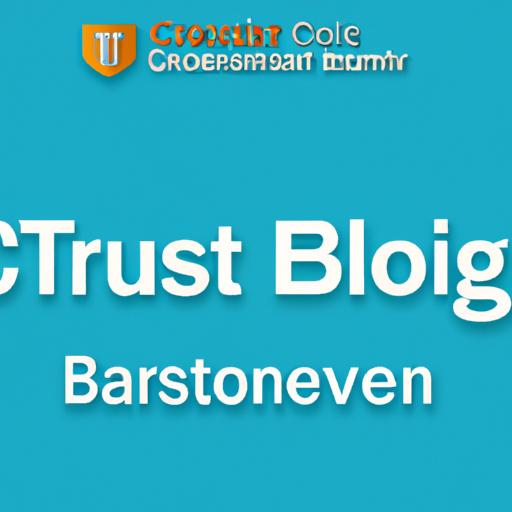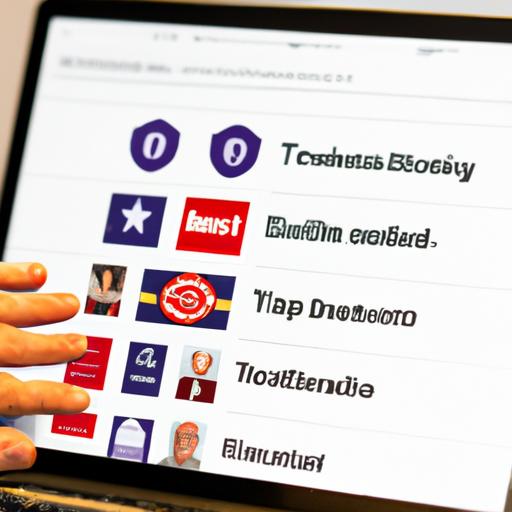Building Trust in Cross-Border E-commerce Transactions
Ready to conquer the world from the comfort of your screen? Well, cross-border e-commerce has got your back! With just a few clicks, you can unlock a world of unique products and reach customers across continents. But hey, hold on a second there – before jumping headfirst into the vast ocean of international transactions, let’s talk about trust. Yes, that elusive little creature that can make or break your cross-border e-commerce dreams. Join us on a journey where we unravel the secrets of building trust in cross-border e-commerce transactions, and learn how to turn uncertain customers into loyal globetrotters. So, grab your passport, hop on, and let’s embark on this trust-packed adventure!
Establishing Trust in Cross-Border E-commerce: Bridging the Gap between Buyers and Sellers
In today’s globalized world, cross-border e-commerce has opened up opportunities for buyers and sellers from different corners of the globe to connect and engage in transactions. However, amidst the vastness of the online marketplace, building trust between buyers and sellers can be a challenging endeavor. It is crucial to bridge the gap and establish trust, as it paves the way for successful transactions and long-term partnerships.
To build trust in cross-border e-commerce transactions, both buyers and sellers need to take certain measures. Transparency is key in fostering trust. Sellers should provide detailed product descriptions, including specifications, dimensions, and materials used, giving buyers a clear understanding of what they are purchasing. Additionally, sellers can offer high-quality product images from different angles, allowing buyers to visualize the product better.
- Provide comprehensive product descriptions including specifications, dimensions, and materials used.
- Offer high-quality product images from different angles.
- Provide honest and accurate information on shipping and handling times.
| Seller’s Responsibilities | Buyer’s Responsibilities |
|---|---|
| Ensure prompt responses to buyer inquiries. | Thoroughly read product descriptions and view images before making a purchase. |
| Offer hassle-free return policies. | Ask relevant questions to clarify any doubts or concerns. |
| Clearly communicate shipping and handling fees. | Follow up on tracking information and confirm delivery. |
Buyers, on the other hand, should thoroughly read product descriptions and view images before making a purchase. Asking relevant questions to clarify any doubts or concerns is essential for building trust. Additionally, buyers should follow up on tracking information and confirm the delivery of their ordered items.
By adhering to these practices, buyers and sellers can establish trust in cross-border e-commerce transactions, creating a safe and reliable environment for online trade. Trust is the foundation of any successful business relationship, and it is through mutual transparency and responsibility that this foundation can be built.
The Role of Secure Payment Platforms: Safeguarding Transactions and Assuring Buyers
In today’s globalized world, cross-border e-commerce has become increasingly popular. However, with the rise in online transactions, the need for secure payment platforms has never been greater. These platforms play a pivotal role in safeguarding transactions and assuring buyers that their purchases will be handled safely and securely.
One of the key ways secure payment platforms build trust is by offering strong encryption measures. By using state-of-the-art encryption technology, these platforms ensure that sensitive financial information, such as credit card details, are securely transmitted and stored. This eliminates the risk of hackers intercepting and misusing the data, giving buyers peace of mind when making online purchases.
Additionally, secure payment platforms often offer buyer protection programs. These programs provide safeguards against fraud, helping buyers to recover their funds in case of unauthorized transactions or disputes with sellers. By offering such protection, these platforms assure buyers that their money is safe and that they will not be left vulnerable to unscrupulous individuals.
Moreover, secure payment platforms prioritize customer privacy. They prioritize stringent data protection protocols, ensuring that personal and financial information is kept confidential at all times. This commitment to privacy helps establish trust between buyers and sellers, encouraging them to engage in more cross-border e-commerce transactions.
- Secure payment platforms use strong encryption technology to protect sensitive financial information
- Buyer protection programs help recover funds in case of fraud
- Platforms prioritize customer privacy and keep personal information confidential
Overall, secure payment platforms play a crucial role in building trust in cross-border e-commerce transactions. By safeguarding sensitive information, offering buyer protection programs, and prioritizing customer privacy, these platforms instill confidence in buyers, encouraging them to engage in more online transactions. As cross-border e-commerce continues to grow, the importance of such platforms cannot be overstated. So, next time you make an online purchase, remember the role of secure payment platforms in ensuring a safe and secure transaction.
Transparency is Key: Building Trust through Open Communication and Information
When it comes to cross-border e-commerce transactions, trust is the foundation on which successful businesses are built. In a world where physical barriers are eliminated by the internet, transparency becomes the key to establishing and maintaining trust between buyers and sellers. Open communication and information flow are crucial in this process, as they allow both parties to understand and meet each other’s expectations.
One way to promote transparency and build trust is through clear product descriptions. Providing accurate and detailed information about the product’s features, specifications, and conditions helps buyers make informed purchasing decisions. Additionally, including high-quality images from different angles and highlighting any potential flaws or imperfections gives buyers a realistic view of what they can expect.
In addition to product descriptions, openly addressing shipping and delivery information is another essential component. By providing estimated delivery times, shipping methods, and associated costs upfront, sellers empower buyers to plan their purchases accordingly. This transparency also helps avoid any misunderstandings or frustrations down the line.
Furthermore, displaying customer reviews and ratings can significantly impact trust-building in cross-border e-commerce. Genuine feedback from previous buyers reassures potential customers of the seller’s reliability and the product’s quality. Encouraging customers to leave reviews and moderating them to ensure authenticity demonstrates a commitment to transparency and fosters a sense of community.
- Feature accurate and detailed product descriptions
- Include high-quality images
- Address shipping and delivery information
- Display customer reviews and ratings
Gaining trust in cross-border e-commerce transactions requires an ongoing commitment to transparency and open communication. By prioritizing clear product descriptions, addressing shipping information, and showcasing customer feedback, sellers demonstrate their dedication to building trust. Remember, transparency is not just a buzzword – it is the key to establishing and nurturing successful relationships in the world of cross-border e-commerce.
Protecting Buyers and Sellers: Implementing Dispute Resolution Mechanisms for Cross-Border E-commerce
Building trust is crucial in the world of cross-border e-commerce transactions, where buyers and sellers may not have the opportunity to meet face-to-face. To ensure a safe and secure online shopping experience, it is important to implement effective dispute resolution mechanisms. By doing so, we can protect both buyers and sellers from potential fraud or dissatisfaction and foster a thriving global marketplace.
One important aspect of dispute resolution mechanisms is the establishment of clear and transparent policies. Sellers should clearly communicate their return and refund policies to potential buyers, outlining the steps and requirements for initiating a dispute. This information should be easily accessible on the seller’s website or marketplace profile, allowing buyers to make informed decisions and feel confident in their purchases.
In addition to well-defined policies, effective communication channels play a vital role in resolving disputes. Sellers should provide multiple ways for buyers to reach out, such as through email, live chat, or a dedicated customer support hotline. By promptly addressing buyers’ concerns and inquiries, sellers can prevent misunderstandings from escalating into full-blown disputes. Furthermore, maintaining a courteous and empathetic tone in all interactions can go a long way in building trust and satisfying customers.
To further enhance dispute resolution mechanisms, third-party mediation can be employed in more complex cases. This involves an impartial party stepping in to facilitate negotiations and find a mutually acceptable resolution. Introducing this neutral intermediary can help minimize bias and ensure a fair outcome for both buyers and sellers.
Trust is the foundation of successful cross-border e-commerce transactions. By implementing robust dispute resolution mechanisms, we can protect both buyers and sellers, fostering a secure and reliable environment for online shopping.
Key Takeaways
And there you have it, folks! Building trust in cross-border e-commerce transactions may seem like a daunting task, but fear not - it’s not as insurmountable as it may appear. After exploring various strategies, from utilizing secure payment gateways to fostering clear communication channels, we’ve gathered an arsenal of trust-building techniques ready for you to employ.
Remember, in the world of cross-border e-commerce, trust is the key that unlocks the treasure trove of opportunities. So, take a deep breath, put on your trusty hat, and dive into the global market with confidence! Embrace the exciting realm of cross-border transactions, knowing that you have the knowledge and tools to bridge gaps, overcome obstacles, and create lasting relationships with customers from all around the globe.
As technology continues to evolve and connect us in ways we never imagined, building trust across borders is no longer a Herculean task. Embrace the opportunities afforded to you by the digital age, always prioritizing transparency, consistency, and reliability. By demonstrating your commitment to delivering exceptional service and valuing your customers’ trust, you’ll become a beacon of reliability and succeed in the vast world of cross-border e-commerce.
So gear up, stay informed, and go forth, brave entrepreneurs, into the world of cross-border e-commerce! Together, let’s build trust, foster connections, and create a global marketplace built on mutual understanding and collaboration. The possibilities are endless, and the rewards are waiting just beyond the border. Trust, transparency, and success await you!
Good luck, and happy cross-border trading!






